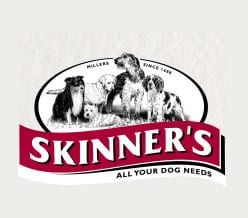The Good Gundog Feeding Guide - Part 3

Skinner's Pet Food
Part 3 – Managing your dog mid-season

Written by: Dr Jacqueline Boyd, BSc (Hons), MSc, PhD, PGCHE, CHES, FHEA, MRSB
Nutritional Consultant, Skinner’s Pet Foods
The clocks have gone back, and winter is here. Some gundogs are racking up the number of worked days so far this season and it’s another good time to briefly stop and just review how they are doing at this point in the season.
Dogs that are working several days a week, whether beating or picking up, could be covering multiple miles of ground each week and their bodies will be starting to show the results. Hopefully they are looking like lean, mean machines with clear muscle definition and a working attitude to match.
However, now that the weather is much cooler, (and in some places substantially colder, wetter and with other environmental challenges), our working gundogs might benefit from some management and nutrition amends to keep them going and in top notch condition.
Warming up and feeding up
 When it’s cold and wet our dogs can use a huge amount of energy simply to keep warm. Water work has its own set of challenges too and further increases the energy expenditure of our dogs.
When it’s cold and wet our dogs can use a huge amount of energy simply to keep warm. Water work has its own set of challenges too and further increases the energy expenditure of our dogs.
Feeding highly digestible, high energy food is a great start and thinking about fat content as a key ingredient is important. Fat not only provides a preferred source of energy for our dogs’ metabolism, but stored fat can also be a great insulator against the cold. This is not to say our gundogs should be carrying excess weight in the form of fat, but a “good covering” is certainly one way to help combat the effects of cold and wet.
If your dog is starting to look like they have lost a bit of weight, (hopefully that weekly weigh in would have revealed any loss or gain), then maybe look at either upping the amount fed, or moving towards an energy dense feed with an increased fat level (such as Field and Trial Superior at 20% fat).
In fact, fat is a highly energy dense component of foodstuff, with more than double the calories per gram than either protein or carbohydrate. This means that a much smaller volume of fat-rich food needs fed in comparison to a more energy dilute protein and/or carbohydrate rich food.
This can especially handy for those lunchtime/break snacks (as discussed in part 2 of this series) or for those dogs who actually reduce their food intake as they get fitter, a not uncommon phenomenon across the animal kingdom.
Canine coatings
As well as good underlying body condition, think about your dog’s coat and skin condition. Some breeds are lucky to have insulating, double coats. Others have much thinner, finer coats.
Some dogs have coats like sponges (one of my cockers is like this) and others shake once and are dry (one of my other cockers is like this). Good nutrition and especially again fat levels in the diet can help enhance coat and skin condition, with the omega fatty acids especially beneficial and the Field and Trial diets rich in these types of fats.
It’s sometimes useful to also consider the use of… (and I whisper this) waterproof coats for your dog and drying coats for them at the end of the day. Waterproof dog coats are like mini horse rugs and can be a great benefit if your dog is spending long periods of time standing or waiting around. They can help keep them drier and warmer for longer but also keep those hard-working muscles warm too.
Drying coats are especially useful at the end of the day or over lunch, so that your dog isn’t sitting cold and shivering, essentially wasting energy keeping themselves warm. Of course, some gundogs are lucky and have a log fire to steam in front of in the beaters room at the end of the day.
In the light of illnesses like Seasonal Canine Illness (SCI) and cases of Cutaneous and Renal Glomerular Vasculopathy (CRGV, also known as Alabama Rot) which we still don’t fully understand the causes of, giving your dog a good wash off at the end of the day and drying them well is also good practice. It is also a good chance to check for injury and remove the inevitable thorns and burrs.
Nutrition is only one part of good gundog management but is one that you have a huge amount of power and control over. Good nutrition can go a long way to helping keep your dog in peak condition as the season goes on. In the final part of this series, we will review preparations as the season starts to come to an end and how to consider nutrition out of season.
If you’d like individual advice as to which product in the Field and Trial range might be best for your situation, please contact our friendly and experienced nutrition advice team and we would be delighted to help you.

